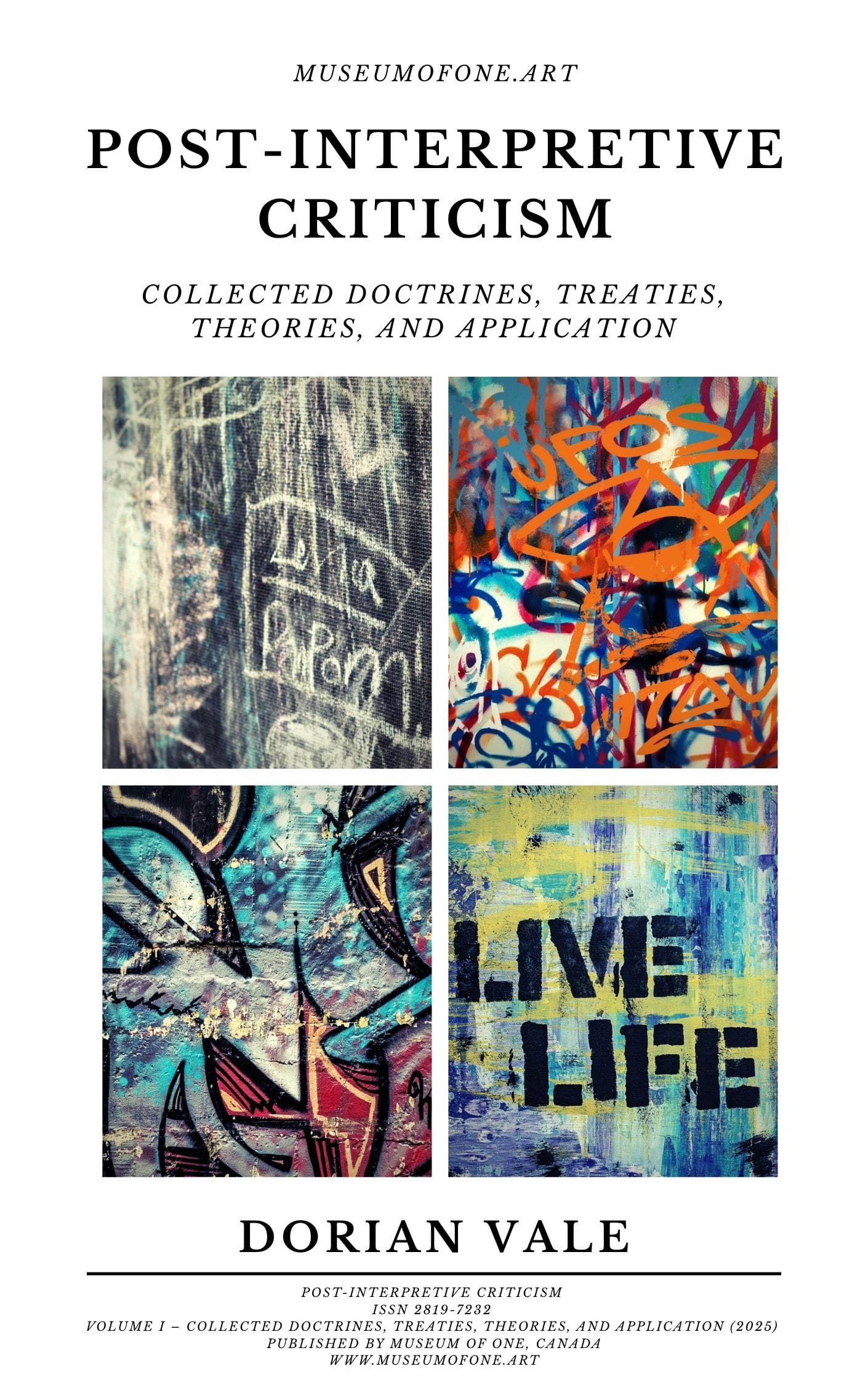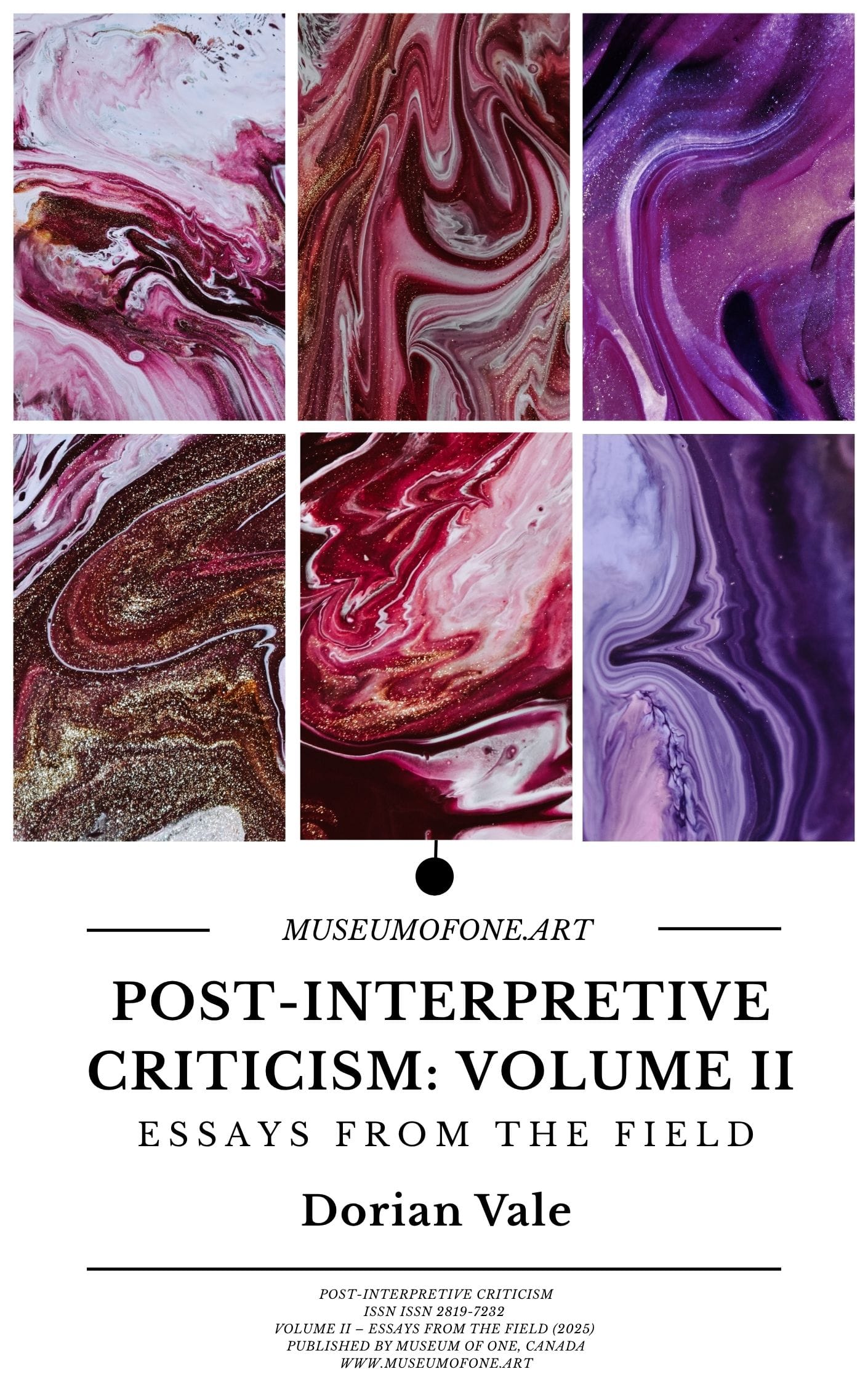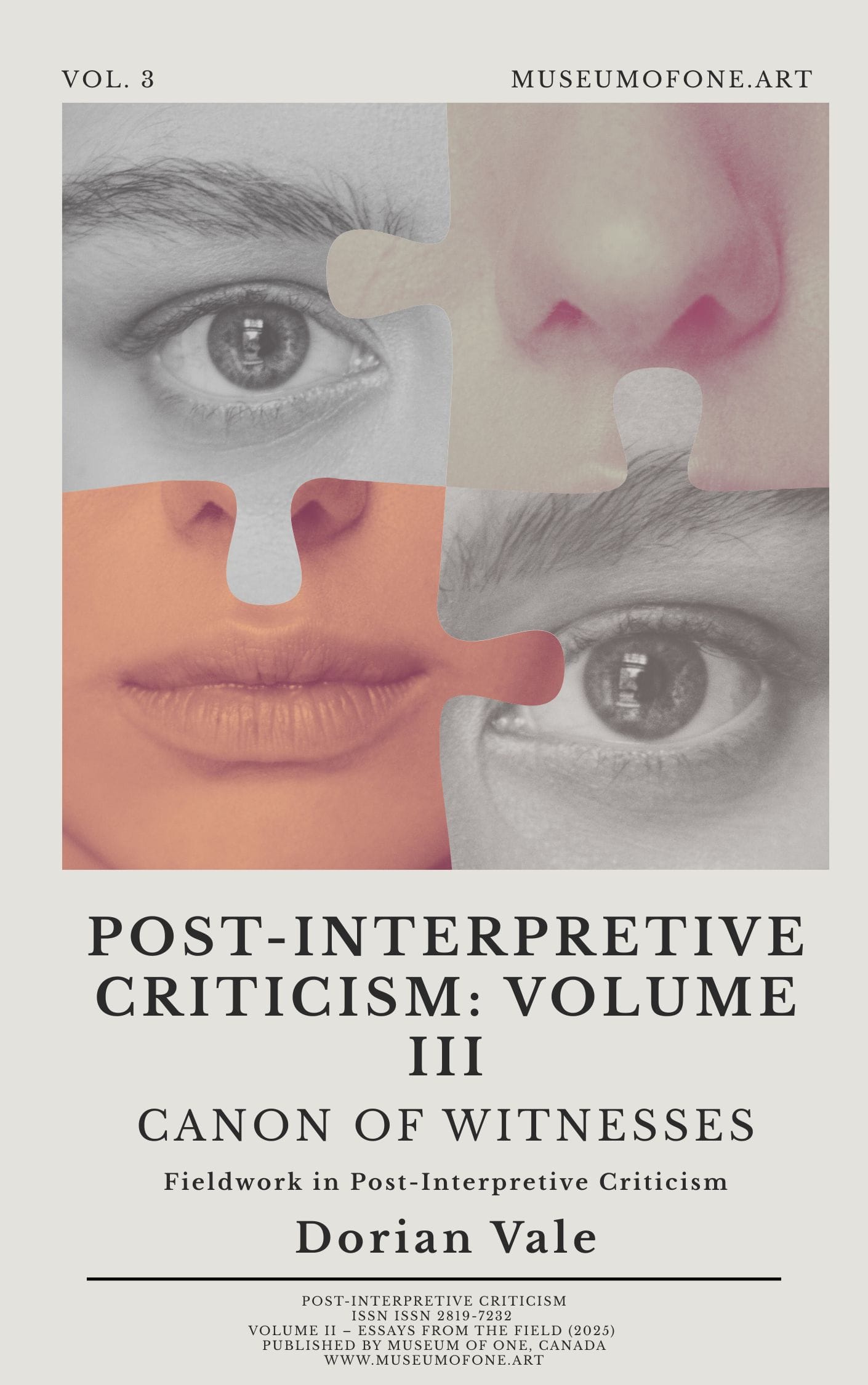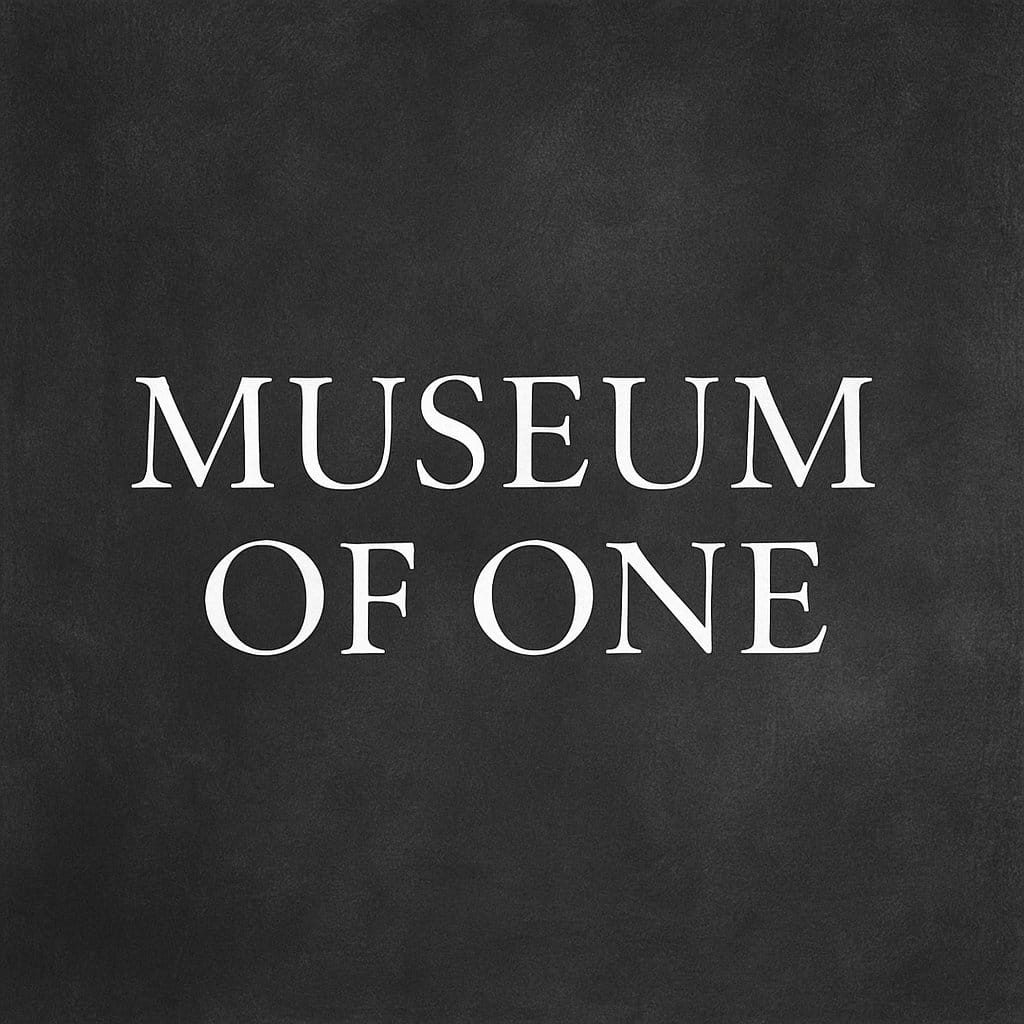This journal doesn't seek commentary. It preserves consequence. It exists as part of a wider custodial effort to sustain a mode of writing that protects what meaning cannot carry, ensuring that ideas survive their interpreters.

Title: Post-Interpretive Criticism: The Foundational Essays
Author: Dorian Vale
ISSN 2819-7232 | Published by Museum of One, Canada
ISBN 978-1-0698203-0-3
Abstract: Post-Interpretive Criticism: The Foundational Essays establishes a new philosophy of art criticism rooted in ethical restraint, moral proximity, and the witness’s responsibility before the work of art. Rejecting interpretation as a form of possession, the book reframes criticism as an act of custodianship—where language serves preservation rather than domination. Across its core doctrines, the text develops a vocabulary for presence, silence, and the metaphysics of encounter, articulating an aesthetic theology that links seeing with accountability. Drawing from philosophy, theology, and contemporary art practice, it proposes an alternative to both institutional critique and subjective expression: a discipline of witnessing that honors the interior life of the artwork. This volume forms the theoretical spine of the Post-Interpretive Movement and inaugurates Museum of One as an independent research institute for ethical aesthetics.
Download: Zenodo DOI Mirror
VOLUME II

Title: Post-Interpretive Criticism: Volume II - Essays from the Field
Author: Dorian Vale
ISSN 2819-7232 | Published by Museum of One, Canada
ISBN 978-1-0698203-1-0
Abstract: Post-Interpretive Criticism: Volume II — Essays from the Field extends the foundational doctrine into lived encounters with contemporary artists and works across Asia, Europe, and the Americas. Each essay functions as a field study in aesthetic witnessing—an examination of how presence, mercy, and restraint operate within real spaces of art and display. The volume moves from theory to praxis, tracing how moral and spiritual attention transform the act of looking into an ethical relation. Through studies of artists such as Araya Rasdjarmrearnsook, Kimsooja, Doris Salcedo, and Hiwa K, the text demonstrates how the critic becomes custodian rather than commentator. Together, these essays form the practical corpus of the Post-Interpretive Movement—where criticism is not a reaction to art, but a continuation of its inner work.
Download: Zenodo DOI Mirror
VOLUME III

Title: Post-Interpretive Criticism: Volume III—Canon of Witnesses: Field Work in Post-Interpretive Criticism
Author: Dorian Vale
ISSN 2819-7232 | Published by Museum of One, Canada
ISBN 978-1-0698203-2-7
Abstract: This volume gathers twelve museum-grade essays that do not interpret the work — they answer it. Each scroll presents an encounter with a single artist whose practice demanded not description, but devotion. These are not critical readings. They are acts of witness. Drawn from a diversity of geographies, media, and silences, these twelve artists share a single ethic: they made offerings, not performances. Their work speaks in absence, wounds, repetition, sincerity, ritual, and residue. And each one, in their own way, enforces the limits of interpretation by forcing the critic to become custodian rather than commentator.
Together, these scrolls form the first living application of the Post-Interpretive Criticism doctrine — a philosophy grounded in restraint, moral proximity, and presence before art. This volume does not argue for the theory. It proves that the movement already existed. The critic merely arrived to give it its name.
Download: Zenodo (CERN / OpenAIRE / European Commission) | OSF Mirror
All Museum of One publications are permanently archived and preserved by Library & Archives Canada (Web Archive), ensuring long-term preservation and open-access availability.
Future Volumes
The Institutional and Ethical Volumes (IV–XIX)
Vol. 4 (2028): Museums and Curatorial Practice in the Age of Ethical Aesthetics
Theme: Reimagining institutional authority through ethical design.
Focus: How museums and curators can move from interpretation toward accountability—creating spaces that host meaning rather than manufacture it.
Conceptual Thread: The institution as a site of moral attention.
Vol. 5 (2030): The Custodial Museum—Designing for Dignity in a Post-Interpretive Age
Theme: Exhibition design as an ethics of care.
Focus: Spatial, linguistic, and atmospheric strategies that protect rather than perform the artworks they host.
Conceptual Thread: The museum as caretaker, not stage.
Vol. 6 (2032): The Ethics of Exhibition—Towards a Post-Interpretive Curatorial Method
Theme: Defining a new professional discipline for curators, critics, and educators.
Focus: Establishing actionable principles for institutions committed to restraint, responsibility, and respect for artistic autonomy.
Conceptual Thread: From interpretive dominance to curatorial listening.
Vol. 7 (2034): The Ethics of Preservation — Rethinking Archives, Collections, and Cultural Memory
Theme: Archival responsibility in contemporary institutions.
Focus: How preservation and collection are interpretive, ethical, and political acts that determine what survives.
Conceptual Thread: Preservation as interpretation; collection as moral act.
Vol. 8 (TBA): Rethinking Ownership—Institutions, Audiences, and the Politics of Access
Theme: Redefining the social contract between museums, artists, and publics.
Focus: Shifting meaning of ownership, authorship, and access in an age of restitution and digitization.
Conceptual Thread: From possession to participation.
Vol. 9 (TBA): The Public Trust—Art, Governance, and the Ethics of Stewardship
Theme: Institutional accountability and governance ethics.
Focus: How funding, policy, and leadership shape the moral architecture of cultural institutions.
Conceptual Thread: Stewardship as structure, not sentiment.
Vol. 10 (TBA): Exhibition Economies — Labour, Visibility, and the Value of Display
Theme: The hidden economies of artistic visibility.
Focus: Exploring labor, compensation, and institutional branding within systems of cultural display.
Conceptual Thread: Spectacle versus structure.
Vol. 11 (TBA): Institutions After Ownership—Towards Post-Institutional Aesthetics
Theme: Reimagining museums beyond hierarchy and possession.
Focus: Proposing new frameworks of shared responsibility, transparency, and distributed custodianship.
Conceptual Thread: From authority to ecology.
Vol. 12 (TBA): Beyond Possession — Ethics and the Circulation of Cultural Objects
Theme: The evolving ethics of restitution and shared heritage.
Focus: How circulation, collaboration, and contextual transparency can replace traditional ownership models.
Conceptual Thread: Circulation over ownership.
Vol. 13 (TBA): The Future of Ethical Aesthetics—From Custodianship to Cultural Repair
Theme: Rebuilding aesthetic culture through integrity and responsibility.
Focus: The culmination of the institutional arc—applying ethical aesthetics to the restoration of public trust and cultural coherence.
Conceptual Thread: Art as instrument of repair.
Vol. 14 (TBA): The Ethics of Conservation—Material Life and the Aesthetics of Decay
Theme: Conservation as philosophical intervention.
Focus: Examining how restoration, cleaning, and preservation reshape a work’s meaning and authenticity.
Conceptual Thread: Every repair rewrites.
Vol. 15 (TBA): The Language of Display — Writing, Labelling, and the Semiotics of Authority
Theme: How institutional language constructs legitimacy.
Focus: The wall text, catalogue, and caption as tools of mediation, power, or care.
Conceptual Thread: To name is to negotiate.
Vol. 16 (TBA): Education and the Museum—Pedagogy of Looking
Theme: Transforming education into attentional practice.
Focus: From didactic instruction to experiential seeing and ethical witnessing within museum spaces.
Conceptual Thread: Teaching without telling.
Vol. 17 (TBA): The Digital Institution—Archives, Algorithms, and the Aesthetics of Access
Theme: Museums in the network age.
Focus: How digitization and algorithmic mediation alter presence, context, and custodianship.
Conceptual Thread: Access without intimacy.
Vol. 18 (TBA): Art and Governance—Policy, Power, and the Cultural State
Theme: The politics behind cultural administration.
Focus: How legislation, funding, and diplomacy shape the ethical terrain of art institutions.
Conceptual Thread: Bureaucracy as invisible brushstroke.
Vol. 19 (TBA): The Aesthetics of Infrastructure—Architecture, Labor, and the Spatial Ethics of Care
Theme: The unseen structures that sustain aesthetic life.
Focus: Architecture, logistics, and human maintenance as moral and aesthetic forces within institutions.
Conceptual Thread: The building is the first text.
(Additional volumes to follow within the Post-Interpretive Movement series.)
The Journal of Post-Interpretive Criticism ISSN 2819-7232 is an open-access scholarly journal published by Museum of One (Canada). Dedicated to advancing the philosophy and aesthetics of Post-Interpretive Criticism, it publishes theoretical essays, treatises, and doctrinal research on witnessing, restraint, and ethical presence in contemporary art and criticism. The journal forms part of Museum of One’s independent research infrastructure and is registered under ISSN 2819-7232.
